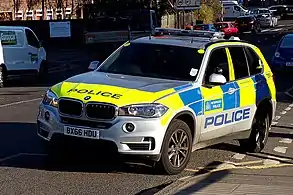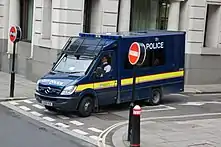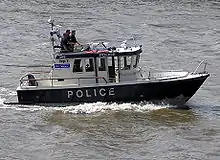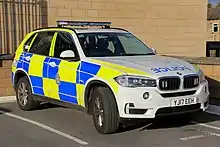Police vehicles in the United Kingdom
The police forces in the UK use a wide range of operational vehicles including compact cars, powerful estates and armored police carriers. The main uses are patrol, response, tactical pursuit and public order policing. Other vehicles used by British police include motorcycles, aircraft and boats.

Incident response vehicle (IRV)
.jpg.webp)
Incident response vehicles (IRVs) are used by UK police to respond to emergencies and to conduct proactive patrols. They are fitted with blue lights and sirens to warn other road users and pedestrians vehicles that they need to make way for the police vehicle. Common vehicles used as IRVs include the Vauxhall Astra, Vauxhall Insignia, Ford Focus, Ford Mondeo, Peugeot 308 and BMW 2 Series. Prisoner transport vans, like the Mercedes Vito, Ford Transit and Vauxhall Vivaro are used as IRVs whilst also have the capability to transport arrested suspects in a cage.
Engine sizes vary according to each forces vehicle procurement policies but range from 1.0 to 2.0l. Although petrol-powered engines once dominated, diesel engines are now becoming much more common due to their superior fuel economy, and therefore lower operating costs. The Metropolitan Police has recently shifted back to petrol powered vehicles as a result of clean air campaigns, as well as introducing BMW i3s as electric models are receive an increasing presence for use as police vehicles.
Officers driving IRVs typically hold a 'response' permit, allowing them to utilise blue lights and sirens to make an emergency response. Some officers may not have undergone the additional training, and as such are only permitted to use emergency equipment when positioned at a scene or to pull over a vehicle. Officers who have undergone additional training to reach 'initial pursuit phase' standard are allowed to pursue vehicles, should they fail to stop.
Marked variants of these cars typically feature a single row and double (in a limited number of police forces) of yellow and blue battenburg police markings on each side of car with 'Police' lettering on the front and rear of the vehicle. Force badges or slogans can usually be found on the front and sides of marked cars in most areas. They all have high-visibility yellow and orange / red chevrons on the back.
IRVs will generally carry equipment and lighting for use at traffic incidents, such as traffic cones, warning signs and basic first aid equipment. Many response cars in the UK now also carry mobile technology which can be linked to police databases and automatic number plate recognition technology.
Armed response vehicles (ARV)

With the exception of the Police Service of Northern Ireland, police officers in the United Kingdom do not typically carry firearms. There are, however, a number of armed response vehicles (ARVs) in each police force area in which authorised firearms officers are carried.
In recent years police forces are merging their resources with other police forces to reduce costs. Forces with a shared armed response capability include Hampshire Constabulary with Thames Valley Police; Sussex Police with Surrey Police; Devon and Cornwall Police with Dorset Police and Bedfordshire Police with Cambridgeshire Constabulary as well as Hertfordshire Constabulary.
All forces use high performance vehicles, most commonly the BMW X5 as ARVs.
Roads policing units (RPU)
Roads policing units vehicles, more informally known as traffic cars, are faster police vehicles used by pursuit trained officers who are tasked responding to serious traffic collisions and conducting high speed pursuits, as well as traffic enforcement. Traffic cars are nowadays more frequently SUVs or estate cars than saloons. This is because they carry an increasingly large load of specialist equipment, such as traffic cones, signs to warn of road closures or collisions and scene preservation equipment. These vehicles are typically fitted with Automatic number-plate recognition systems to assist in traffic enforcement.
The most common traffic cars include the BMW 3 and 5 Series, the BMW X5, and the Land Rover Discovery. These may be marked or unmarked. Historically, cars such as the Wolseley 4/50 & 6/80, Austin Mini, Jaguar Mark 2, Rover P6, Rover SD1, Austin Metro, Rover 800 and Vauxhall Senator were commonly used.[1][2][3]
Most roads policing vehicles are rated as 'high-performance', requiring traffic officers have undergone additional driving training to the 'advanced' standard. Officers are also commonly trained in Tactical Pursuit and Containment (TPAC).
Some forces' roads policing units also operate road crime teams, who use unmarked and high performance – like the Audi S3, Golf R, Škoda Octavia VRS, Ford Focus RS and Vauxhall Insignia VXR– to primarily focus on organised criminals using the road committing offences and are likely to fail to stop.
Area cars
Area car is the category of police vehicle that sits between the IRV and the roads policing unit. They are usually higher-performance vehicles similar to those in the roads policing unit but operated by officers on response teams who respond to general emergency calls. Area car drivers are trained in advanced driving with initial and advanced phased pursuit. Only a small number of services use area cars, the most prevalent being the Metropolitan Police who solely utilise the BMW 5 series – in the 525d and 530i variant.
Motorcycles
Motorcycles are used by a number of forces in the UK, usually by the Road Policing Unit. Police motorcycles are also used in road safety initiatives such as Bikesafe, a national program to reduce motorcycle casualties in which police motorcyclists provide advanced rider training to members of the public.[4]
Some Metropolitan Police Special Escort Group officers also use motor cycles. These officers may be identified by their side arms as they are the only armed motor cycle police in London, apart from a small section of the Parliamentary and Diplomatic Protection unit who use motorcycles to respond quickly to incidents faster than the PaDP ARVs can.
The motorcycles used by police include the BMW R1200RT, Honda ST1100 Pan-European, and Yamaha FJR1300. The Honda ST1300 Pan-European was the most popular bike, but it was withdrawn from service by most forces in 2007,[5] following the death of a Merseyside police motorcyclist in 2005 in an accident caused by an instability in the model when outfitted with police equipment.[6]
Vans and minibuses
Police vans, such as the Ford Transit, Vauxhall Movano and the Mercedes Sprinter, are widely used across the United Kingdom and incorporate a cage to hold prisoners. Although in the United States it is usual to carry a prisoner in a police car, some British forces do not permit this, as most police cars have no barrier between the front and back seats to protect the officers. Each police force has different policies on prisoner transportation. Some allow compliant prisoners to be transported in response cars, ensuring that one officer sits in the rear with the prisoner, and the prisoner sits behind the passenger seat.
Larger vans are also used to act as mobile control room at major incidents, and may also carry specialised equipment such as hydraulic door entry and cutting tools.

Minibuses are used to carry groups of police officers, for example to public order and major incidents, and for inner-city patrols. One notable example is the Mercedes Sprinter used by the Metropolitan Police's Territorial Support Group. Other public order minibuses include the Vauxhall Movano and the Iveco Daily. They are usually fitted with riot shields to protect the windscreen from damage. More recently, as a result of reenforced glass being used, public order vans are not fitted with cages over the windscreen.
.jpg.webp)
Other vehicles

- Dog unit cars/vans
- Horse trailers
- Vehicle removal trucks
- Mobile custody units
- Bicycles
Livery and lighting
Almost all police forces use the battenburg livery of yellow and blue checks for their vehicles, on top of a white, blue, or silver base vehicle colour. Silver became popular in some forces because of the higher resale values when sold. Most cars use retroreflective livery on the sides and red and yellow chevrons on the rear. Most also carry slogans, the force crest and contact information.
Most police cars, vans and minibuses have aerial roof markings that help aircraft crew identify them. These can include the unique force code, vehicle identifying mark, or police division that the vehicle belongs to.
Under the Road Vehicle Lighting Regulations 1989, police vehicles may display blue flashing lights to alert other road users to their presence or when the driver feels that the journey needs to be undertaken urgently. These lights are usually mounted on the roof and incorporated into the standard vehicle system of external lights. Most police vehicles are also fitted with a siren. In addition to blue lights, many traffic and incident response cars are fitted with flashing red lights that are only visible at the rear of the vehicle. These indicate that the vehicle is stopped or moving slowly.[7]
Equipment
Police vehicles may carry:
- Speed gun
- Enforcer
- First aid kits
- Traffic cones
- Police signs
- Fire-extinguisher
- Torch
- Breathalyser
- Personal flotation device
- Stinger
Whilst officers typically carry their personal equipment – such as their baton, CS/PAVA spray and Taser on their body – armed officers store most weaponry in a gun safe. This is located in the rear of the vehicle, and can be accessed from the front. Armed officers do, however, always carry their other PPE and sidearm on their person.
Runlock system
Most cars and police motorcycles are fitted with a 'Runlock' system. This allows the vehicle's engine to be left running without the keys being in the ignition. This enables adequate power, without battery drain, to be supplied to the vehicle's equipment at the scene of an incident. The vehicle can only be driven after re-inserting the keys. If the keys are not re-inserted, the engine will switch off if the handbrake is disengaged or the footbrake is activated; or the sidestand is flipped up in the case of a motorcycle. Runlock is also commonly used when an officer is required to quickly decamp from a vehicle or to keep the vehicle Mobile data terminal running. By enabling Runlock, the car's engine can be left running without the risk of someone stealing the vehicle: if the vehicle is driven normally, it will shut down, unless the Runlock system is turned off.
Aircraft
_at_Heathrow_(8053379762).jpg.webp)
.jpg.webp)
All police air support in England and Wales is provided by the National Police Air Service (NPAS). NPAS uses Eurocopter EC135 and EC145 helicopters, alongside Vulcanair P68R planes. Twin engined aircraft are required, as air support units (ASU) are often required to fly over urban areas.
Aircraft are fitted with an array of surveillance, navigation and communication technology to help them with a wide variety of tasks. The specific tasks that any one police helicopter performs will vary from force to force, but common deployments are for missing person searches, vehicle pursuits, the tracking of suspects, and maintaining public order.[8][9]
Scotland and Northern Ireland have separate air support units. Police Scotland utilises a single EC135, whilst the Police Service of Northern Ireland operates 2 EC135s and 1 EC145.
Police aircraft can be used for MEDEVACs, however, these are rarely performed due to the availability of HM Coastguard helicopters and charitably funded air ambulances – both of which offer enhanced medical care with the availability of a paramedic and/or doctor on board.
Pilot
A single pilot civilian operates each aircraft. Most pilots operating police aircraft come from a military background – and as such have the required flying hours and experience to safely fly at low-levels and for prolonged periods of time.
Tactical Flight Officer (TFO)
The standard crew in a police helicopter consists of 2 TFOs. A front seat observer is responsible for operating the helicopter's surveillance systems. The rear seat observer, responsible for communications using the TETRA radio and downlink systems. NPAS' P68 fixed-wing aircraft only operate with one TFO due to weight restrictions.
TFOs are sworn police officers who have extensive experience on the ground, and also carry all the equipment a normal police officer would onboard – should the aircraft be required to land to assist or make an arrest. All pilots are civilians, and have no police powers.
Watercraft

Police forces whose area includes significant waterways often include marine support units. Not only do these units police the waterways, but they also maintain a capability for waterborne rescue, usually in co-operation with HM Coastguard.
See also
- Battenburg markings
- Jam sandwich livery (Phased out of London Metropolitan Police Service in 2012)[10]
References
- Ant Anstead (2018). Cops and Robbers: The Story of the British Police Car. William Collins.
- "Police cars since the 1950s". Guardian. 3 June 2009.
- Keith Adams. "Police cars : Rover/Land Rover". AROnline.
- "Bikesafe". Retrieved 12 October 2009.
- "Police withdraw Pan over safety concerns". Motorcycle News. 14 May 2007. Retrieved 16 July 2007.
- "Police bike is 'serious threat'". BBC News. 27 April 2007. Retrieved 12 October 2009.
- "UK Emergency Vehicles > Information > Blue Light Use". UK Emergency Vehicles. 2009. Archived from the original on 18 February 2009. Retrieved 7 March 2009.
- "What We Do". Western County Air Operations Unit. 2004. Archived from the original on 16 December 2008. Retrieved 30 December 2008.
- "Metropolitan Police Service – Air Support Unit". Metropolitan Police Service. 2009.
- "Met Police cars to bum - Crime - London 24". web.archive.org. 1 May 2016. Archived from the original on 1 May 2016. Retrieved 16 December 2018.
External links
| Wikimedia Commons has media related to Police vehicles of the United Kingdom. |

